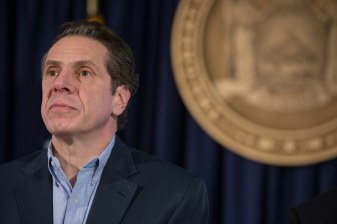Even a Paltry $150M For Tappan Zee Transit Is Too Much For Andrew Cuomo
Earlier this week, Streetsblog reported that Governor Andrew Cuomo is dishonestly overstating the cost of building Tappan Zee Bridge transit. Cuomo has repeatedly said that building a 30-mile bus rapid transit system would cost $5 billion, and that the state can’t afford to spend that much. But that number is inflated by the inclusion of billions of dollars in highway improvements, like new climbing lanes for trucks, many of which are entirely unrelated to providing transit.
By repeating the false $5 billion number, the governor is not only overstating the cost of a built-out, full-featured bus rapid transit corridor, he’s also glossing over low-cost, incremental steps toward better bus service, steps which his administration has refused to take. One of the small, high-impact steps that transit advocates have called for involves building less than a mile of infrastructure to better connect bus riders to Metro-North. Those calls have gone unheeded by the governor so far.
“In theory is a mass transit system across the state a great idea? Of course, of course,” said Cuomo in a press conference held Tuesday. “The question then becomes the reality of the situation, and the cost of the situation. And to put in a bus system now, for Rockland County and Westchester would roughly double the cost, from five billion to ten billion.”

But “five billion” is not the deal breaker. It appears that there is almost no cost that Cuomo is willing to pay for mass transit.
“This is a red herring that it’s going to cost $5 billion to do BRT and therefore we’re not going to do anything,” said Jeff Zupan, a senior fellow with the Regional Plan Association.
In February, Zupan testified before state officials as part of the official public comment period for the new Tappan Zee Bridge. He argued that given the lack of funding, it wasn’t necessary to build the full bus rapid transit system simultaneously with the new bridge, but that the state should take additional steps to improve transit in the short term [PDF].
“The new bridge should include a three-quarter mile bus-only ramp at the Westchester County side at the time the new bridge is built for buses to directly reach the Tarrytown train station, providing a congestion-free link between bus and rail,” Zupan said in February. “This ramp needs to be integrated into the initial construction of the bridge.”
In a newly released document from last year, the state estimated that a Tarrytown connector and new Tarrytown BRT station would cost just $151 million, including all soft costs [PDF]. Yet despite the low pricetag, Zupan said, the state has not taken any of the necessary steps to build this small but important addition to the bridge. “To date, they haven’t responded,” he said, “and from what I understand, they haven’t asked the bidders to provide a separate cost estimate for the option of building a bus ramp to the Tarrytown station.”
The governor’s office has not responded to Streetsblog inquiries about the Tarrytown connector.

With the Cuomo administration having agreed to open the bridge’s extra “emergency vehicle lanes” to buses during rush hour, Zupan argued, the Tarrytown connector could be the second step in a gradual rollout of better bus service across the Tappan Zee Bridge, with more to follow. “Between now and the time the bridge opens, they should look at whether the fourth lane that exists from the top of the Palisades down to the river would work as a bus and carpool lane,” he suggested. “If that works, then you can start getting into the big bucks.”
Finally, Zupan urged that the state restart its transit planning for the corridor, which it cancelled entirely last October. He suggested it could be worthwhile to pursue a scaled-back bus rapid transit system, limited to the most congested part of the I-287 corridor between the Palisades Parkway and White Plains, though questions still remain about demand for both car lanes and bus service (traffic on the Tappan Zee Bridge has declined since 2005, and the creation of a new bridge with higher tolls will likely change regional travel patterns further).
If Andrew Cuomo were pursuing the lowest-cost bus improvements available for the Tappan Zee Bridge while doing the planning and engineering to ensure that bigger transit projects were shovel-ready for a later date when funding became available, it would be much easier to take seriously his claims that he’d build transit if the state could afford it.
“It can be done incrementally,” said Zupan. “That’s really the conflict with the way the governor is spinning it.”
